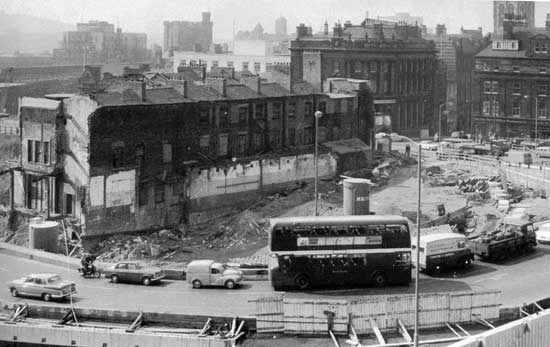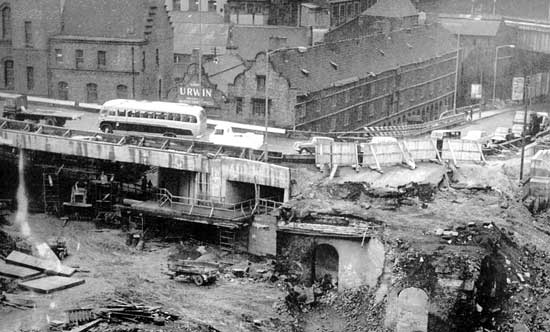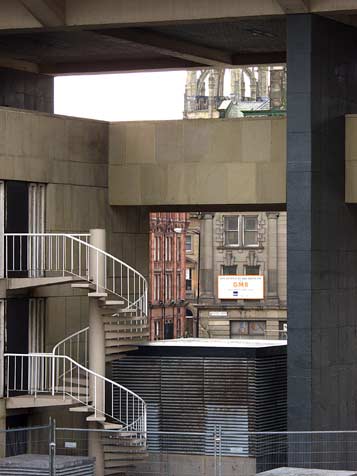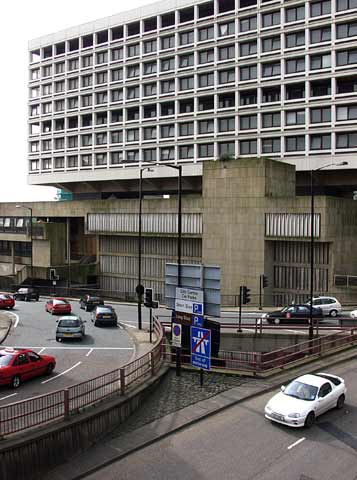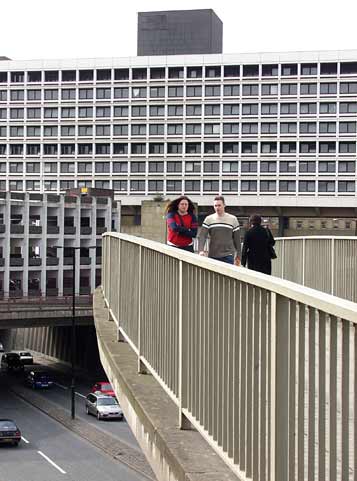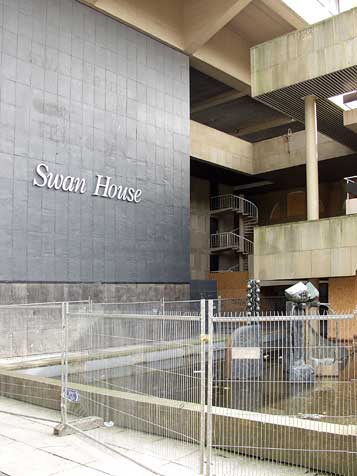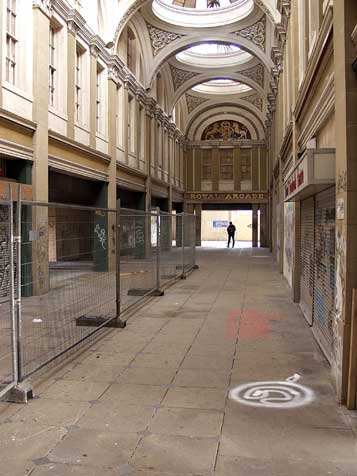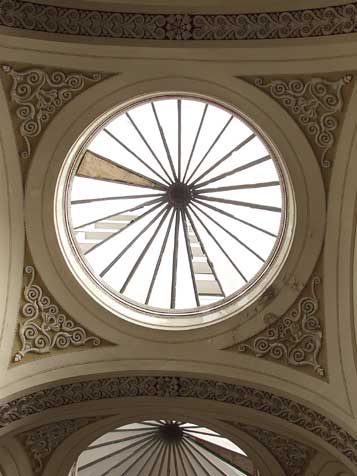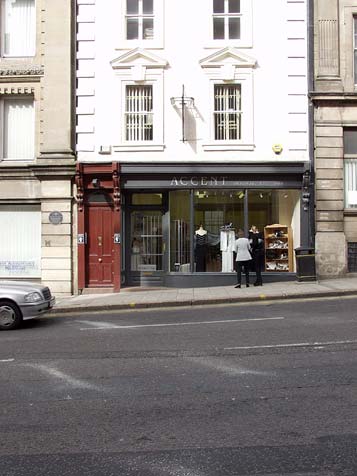|
|
 |
Domus Cygnus
Sat. 23rd Mar., 2002
|
|
|
During the 1960s many parts of Newcastle went under the bulldozer. Here, at the junction of Mosley Street and
Pilgrim Street, on the road to the 1930s Tyne Bridge the grand plan was to replace and widen a rail bridge, construct a road tunnel through route, to become the Central Motorway, and erect the north's
version of the London Post Office Tower.
The Government skyscraper was intended for the General Post Office Telecommunication headquarters, since privatised at great public expense by Tory
Thatcher in 1984.
The building was named after the region's famous scientist, Joseph Swan inventor of the light bulb and the
dry photo process.
|
|
 |
©1965 Newcastle Chronicle & Journal Ltd.
|
|
Above is the scene in April 1965, and we catch a last glimpse of the houses that existed along the eastern side of Pilgrim
Street.The stretch of road nearest the camera is destined to become part of the massive roundabout, but during the development was a two way relief for traffic to and from City Road and the Tyne Bridge. The original
Pilgrim Street runs right to left at the far end of the partly demolished building, and Mosley Street runs into the distance from the end of that old building.
|
 |
©2000 Newsquest (NE) Ltd
|
|
About the same time, from the opposite side is the link from City Road. That long building with the "Urwin" sign is the Holy
Jesus Hospital built in 1681. It was for years the "Joicey Museum" of local heritage, but this closed in 1994 and it now stands empty.
The foreground reveals the remnants of Grainger's Royal Arcade. In the
1830s Grainger's plan for a corn exchange here was blocked by the Town Council. He used the site for a beautiful shopping arcade also housing offices, a Post Office, some banks and a steam vapour bath, topped with
eight glass domes in the roof.
The shopping arcade was a financial failure and it was closed in 1963 and in the name of progress was swept aside. The lower parts are visible here. The plans called for the
removal of the arcade and its numbered stones stored on spare land in Shieldfield. Either by bad luck or conspiracy (choose your theory!) the numbers were written in chalk and they all vanished during the first
rainstorm. This meant that the planned reconstruction was impossible.
|
 |
 |
©2000 Newsquest (NE) Ltd
|
|
In 1968 from almost the same vantage point the massive building was taking shape. It is perched on massive stilts to allow the
the roundabout underneath and was destined to be the GPO Telecommunications headquarters. At the time building developments were watched with increasing disbelief.
Some said that it was a bold expression of
modern progress. At a time when the telephone was still cutting edge technology and the Telstar and Early Bird satellites allowed sound and pictures to span the globe, this centre for electronic communications
lifted its skirts to allow the accepted meteoric rise in road transport to flow around its massive legs. Other watchers saw it as a monument to the wanton destruction of a proud heritage and its replacement with out
of scale cubic carcasses lacking character, that condemned future generations to an architectural wilderness.
|
 |
|
Thirty-four years on and it still stands defiant at the northern end on the Tyne
Bridge. The traffic still flows around it, or rather at peak times during the week stands fuming in homage to the modern deity, car congestion. So much for the bold provisions of the 1960s for road
transport
In 1984 Thatcher sold off the public telecommunications network to her big business friends and they gained billions to shore up their champagne lifestyles at the expense of the real
owners; we taxpayers.
The new British Telecom PLC used this building for some time, but during another money grabbing scheme hatched by a new gaggle of greedy high executives it was sold off to
pay for their disastrous speculative gambles that lost billions and threatened their lifestyles.
|
|
|
 |
 |
|
Above, the view from the northern part of Pilgrim Street shows the central Swan House white lattice with the small
brown Australia House, occupied by that country's cultural council and office for emigration until the 1980s.
Nearer, the Bank of England building with its long high windows, now stands empty.
This view along the side of the old Bank building shows Alderman Fenwick's house.
Ironically, the new buildings, erected with optimism but now overpriced, are shunned by business.
Swan
House is now undergoing conversion to city housing. It remains to be seen how well this will go down, as there are few and well hidden vehicular access points, but a nearby public car park may be useful.
|
|
|
|
|
 |
 |
 |
|
The area beneath Swan House is a public square with a small pond and sculptures that forms the crossing of the
many footpaths connecting the parts of the city sliced asunder by the Central Motorway.
Here is a glimpse of the motorway beneath the elevated walkway connecting Pilgrim Street and Manors. This
pavement is on the same level as Pilgrim Street, as the road was cut into the ground, roughly following the course of the lower Lort Burn.
The windows of Pilgrim Street can be seen in the
distance, and that structure on the extreme left is the Manors car park. Its lower floor is at ground level at the entrance.
|
|
|
The central square is now littered with builders' fences and construction rubble.
The name wall is faced in
slate, and the previous name letters have left their mark. The original sans serif upper case Swan House logo is just discernible, and below that the now discarded 1980s Telecom logo. The later softer
italicised British Telecom style remains. This was hatched up to try to persuade us to think of the greedy company that was amassing millions in profits per minute as warm cuddly and believable.
A
replica of Joseph Swan's original light bulb used to be displayed in a glass case here for many years. That has gone now, and now those temporary fences curiously protect us from the fierce sculptures.
|
|
|
©1961 Jimmy Forsyth
|
|
 |
|
The Royal arcade failed as a shopping experience because of it location. The photo above was taken by Jimmy
Forsyth in 1961. It looks forlorn and it closed in 1963, and it was finally pulled down to make way for the road scheme in 1964.
The view to the right is the sad copy, constructed from plaster and
wood, like a film set, under Swan House.
There were retail units here, newsagents, and sandwich shops, catering for the Swan House workforce. The now boarded shops are the canvas for graffiti
artists.
A lot of the squiggles are mere signatures, but others leave more profound messages. As a vegetarian, I cannot say if ham and eggs help, but the artist has surely caught the essence of
this street sized theatrical backdrop.
|
|
|
 |
|
|
 |
 |
|
The owners of this building, for to be sure this is not a public area any more, have even let their false fašade
crumble. The roof domes are now open to the elements and the paint and plaster is peeling.
I wonder if the new owners will include this in their renovation plans. Will they refresh the paint job,
or sweep away this copy in favour of some other figment of the imagination?
The original arcade design was by John Dobson and it opened in 1832. It was based on the successful Burlington Arcade in
London, but because it lead only to Manors and the Quayside, the posh shoppers from Pilgrim Street would not see Royal Arcade as a fashionable route and it withered as a commercial venture. The other
facilities offered by the original building worked and only ceased when demolition was due.
Joseph Swan was chosen as a name for this icon to the white heat of technology, as he was Newcastle's most well known scientist. He was born in Sunderland, but he became a partner in Mawson's, a chemical and drug manufacturer. It was based here at 13 Mosley Street at the time, and it was here that Joseph invented his electric light, and photographic process using dry bromide, that continues to this day. Previous photos had to be taken on wet plates.
Whilst it is pleasing that the now empty Swan House is to be put to some commercial use, it is still a matter of regret that it is no longer owned by and dedicated to the people. The original
stones from the Royal Arcade still lie buried under a playing field in Shieldfield. This may form a surprise for future archaeologists!
|
|
 |
|
|
 |
 |
|
Site and contents (unless otherwise stated) ©
Tim. Pickford-Jones and Timmonet, Newcastle upon Tyne, United Kingdom.
|
|
|
|
|
|
|

